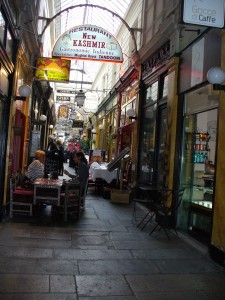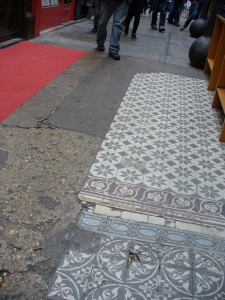 The arcades of Paris (les passages couverts) were a shopping sensation in the 19th century and they are still famous, not least because Walter Benjamin’s great unfinished work The Arcades Project (Das Passagen-Werk) used a study of the arcades as a way of revealing insights into the realities of urban living.
The arcades of Paris (les passages couverts) were a shopping sensation in the 19th century and they are still famous, not least because Walter Benjamin’s great unfinished work The Arcades Project (Das Passagen-Werk) used a study of the arcades as a way of revealing insights into the realities of urban living.
There were some 150 of these arcades built between 1800 and 1850. In their day they offered a treasure-trove to shoppers in Paris away from the weather and the dirty, unpaved streets. Now there are fewer than 20 left, most of them in run-down condition but still offering a variety of shopping and eating experiences. The pavements – or floors – of the arcades carry the story of their decline (or sometimes their revival, as in the case of the almost-glamorous Galerie Vivienne).
 In a stretch of the Passage des Panoramas that I photographed parts of the original paving had been replaced by asphalt, but there were some sections of flagstone and a few shops had remnants of the original coloured tiling – a different pattern for each shop, sometimes with the name of the original business spelt out in tiles. Others had rectangles of synthetic carpet outside their premises.
In a stretch of the Passage des Panoramas that I photographed parts of the original paving had been replaced by asphalt, but there were some sections of flagstone and a few shops had remnants of the original coloured tiling – a different pattern for each shop, sometimes with the name of the original business spelt out in tiles. Others had rectangles of synthetic carpet outside their premises.
